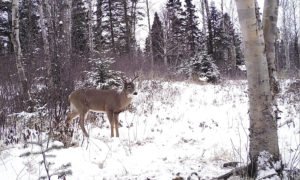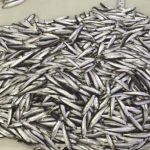My deer hunting career in northwestern Ontario began in the mid-1970s. In those days, whitetail deer east of Kenora and north of Minnesota were as scarce as hen’s teeth. Brutal winters in the late 1960s and early 70s crushed a deer herd that had already been at a relatively low level. Deer hunting in those days involved much traipsing around a snow-covered woods, looking for deer sign. And I mean any sign. Seeing a track was an incredibly exciting event. Finding droppings, a rub or scrape induced something akin to a religious experience. Actually seeing a deer—never mind killing one—was a big deal. It stayed this way until about the mid-1980s. Then, slowly, the deer herd along the North Shore of Superior, and particularly around Thunder Bay, started to grow. Why this happened remains a popular debate, but there are a few theories.
In the 1980s, the forest industry in northwestern Ontario went into high gear. There was much fibre taken, and many large cuts in the forest were made. These huge disturbances would traditionally have been moose magnets. However, cuts that were made down the North Shore of Superior, and along the Minnesota border, seemed to fill up with deer. The rapid increase in deer was remarkable. Another huge change that happened in the 1980s and early 1990s was the arrival of urban deer in Thunder Bay and many small communities. Where once a deer sighting was a novelty, it quickly became a regular occurrence. Why urban deer suddenly took hold so strongly is not entirely clear.

The mid-1980s was also when winters began to moderate and snow depths decreased. It wasn’t a massive change, but it seemed to make enough of a difference to goose the deer population. However, the unexpected side effect of more deer was the introduction of a fatal parasite to moose called brain worm. While deer are carriers of brain worm, it’s moose that get it on the chin when infected. I can remember hearing about the first cases of disoriented moose in the late 1980s, several of which wandered into the city of Thunder Bay, only to be put down. The number of brain worm moose would only increase through the 1990s.
In my entirely non-scientific estimation, the peak of the deer herd in the Dryden, Emo and Kenora Fort Frances regions took place sometime between 2007-2009. It was absolutely amazing how many deer were on the landscape. I can recall driving through some farm fields north of Dryden one November morning. We counted 100 deer in fields before we got to the hunting grounds. It was pretty clear the herd had grown to an unsustainable size.
Around Thunder Bay, the herd would peak a few years later, in 2011-2012, although the numbers would never get as large as they were in the far western part of the region.
There were some very large bucks taken in the northwest between 2001-2012, and the region became a real contender for some world record racks. The number of deer certainly made for a good hunting situation, and even areas like Nipigon had more deer than would have been expected for a habitat with such a harsh climate.
But, as sometimes happens, Mother Nature put her foot down and the northwest’s deer herd got a serious adjustment.
The winter of 2012-2013 saw the first old-fashioned winter in several years. The cold came early, and stayed well into April. Snow depths were serious and this impacted deer survival. Many large bucks died that winter and the survivors were notably thin and weak that spring. This winter would have been enough to thin the herd. Unfortunately, the winter of 2013-2014 brought more of the same. This double whammy really took the stuffing out of the herd. The huge herds that had been found around Dryden, Vermilion Bay, Emo and Kenora took it especially hard. The Thunder Bay and region deer herd was not spared, although the urban deer seemed to do ok. On the properties I regularly hunt and monitor, the deer population was cut in half. Most of the mature bucks disappeared, and only the youngest, healthiest animals made the cut.
Despite that downturn in deer, the population has made a rather quick rebound. There are many does with twin fawns this year, and the number of young and medium-sized bucks is very noticeable. As I write this, the northwest has had one of the gentlest falls in recent memory; the leaves were still green in early October.
Only time will tell if the deer herd rebounds to the heights it reached a decade ago. Those of us who love deer, hope that Mother Nature can find a way to allow both deer and moose to find a good, sustainable level in the years ahead.


